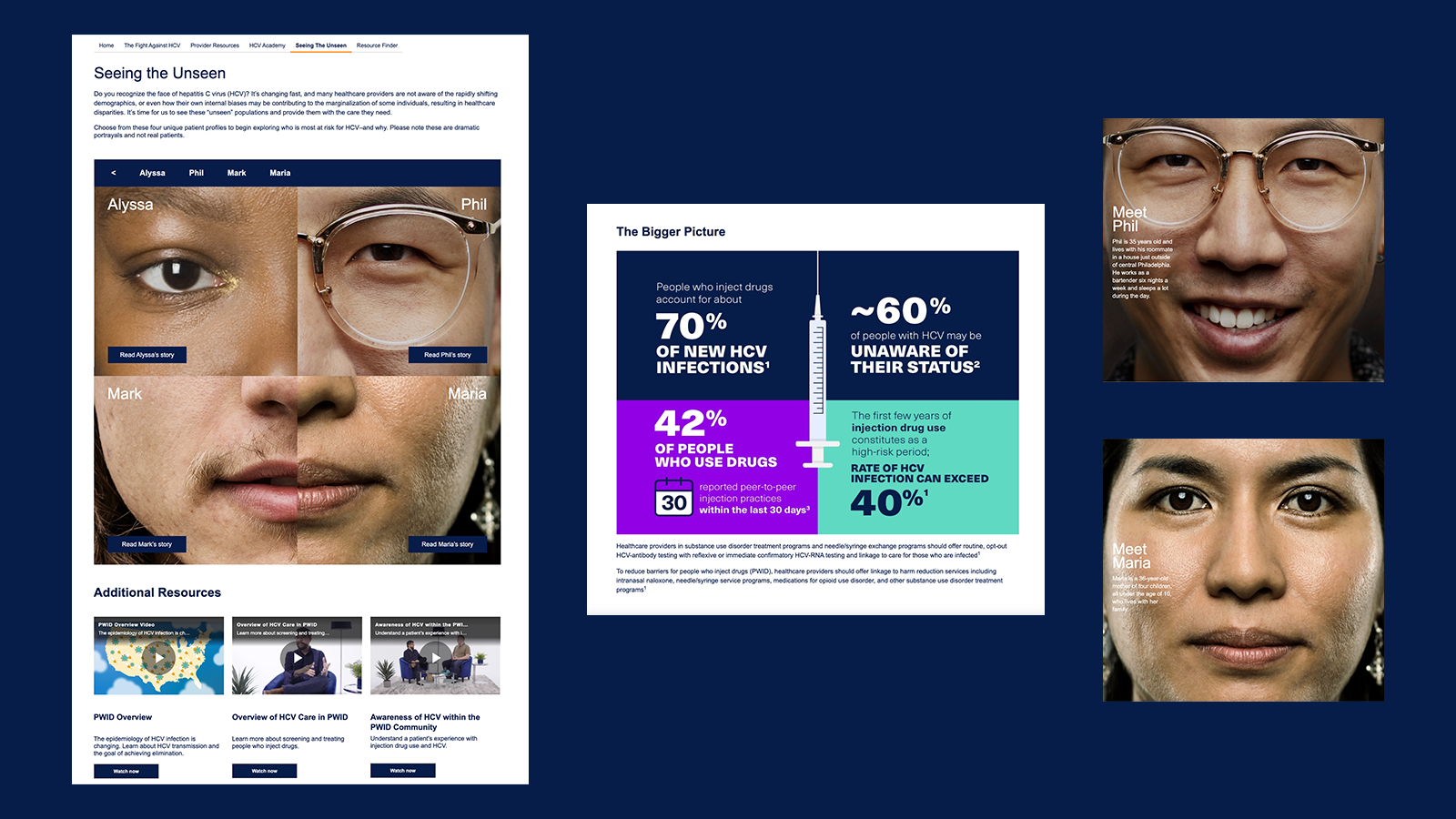Health Equity: It’s Only Human
Human beings make up a vast mosaic. There are billions of us worldwide, speaking thousands of different languages, living in a million different ways. Yet, beneath the untold number of our individual experiences, we are 99.9% genetically identical.1 If our bodies share so much in common, why are there so many differences in healthcare quality and outcomes?
A few examples quickly paint a stark picture of healthcare disparities in the US:
-
Approximately 25.94 million Americans had no health insurance as of 20222
-
From 2000 to 2019, Black and American Indian people had the highest overall mortality rates3
-
Compared to wealthier Americans, those living in low-income areas are at increased risk for mental illness, chronic disease, higher mortality, and lower life expectancy4
-
Black and Hispanic patients make up only 2–13% of clinical trials, even though they account for 33% of the US population5
Clinicians are critical players in healthcare delivery and outcomes, but “social determinants of health” may play an even bigger role, according to the 2022 National Health Care Quality and Disparities Report.6 Health equity happens when “everyone has a fair and just opportunity to attain their highest level of health,”7 but we still have a long way to go before achieving it. However, all of us in the healthcare community can take steps now to help close the health equity gap.
At Avant Healthcare, we believe medical education can be a powerful tool in helping clinicians better understand how to serve the needs of a diverse patient population—especially those living in medically underserved communities. That can mean ensuring diverse representation in patient cases and providing education on a host of clinical topics, including shared decision-making, how symptoms present across diverse populations, and raising awareness about the unique challenges faced by poor or marginalized communities. With this goal in mind, we have worked with our client partners on several key initiatives, including those in hepatitis C virus (HCV), women’s health, and dermatology, which are detailed in the case studies below.
If, at our essence, we’re essentially 99% the same, shouldn’t access to quality healthcare be an equal opportunity for all of us? Health equity demands more than our attention. It calls for our action—because it’s the human thing to do.
See how Avant healthcare is helping clients take action for health equity.
Seeing the Unseen
Recognizing the changing faces of hepatitis C virus (HCV)

HCV health equity facts:
-
Non-Hispanic Blacks had a higher HCV-related mortality rate (6.31 per 100,000) compared to non-Hispanic whites (3.35 per 100,000)8
-
An estimated 80% of new HCV infections occur among people who inject drugs9
-
Gay and bisexual men involved in high-risk behaviors are at increased risk for hepatitis C if they are engaged in high-risk behaviors10
Patients with HCV can seem invisible. Many who have chronic HCV don’t have symptoms.11 Yet, over half of those infected with HCV go on to develop chronic, long-term infections that can result in cirrhosis and liver cancer.11 In light of potential internal biases and the changing demographics of the patient population, our client wanted to create an online resource that would provide clinicians a greater window into seeing who is most at risk for HCV and why.
We developed the “Seeing the Unseen” digital campaign to help clinicians better understand patients with HCV from a holistic and socioeconomic point of view and to increase their compassion for this patient population. Featuring four patient portrayals with unique stories, “Seeing the Unseen” showcases the social and financial challenges many HCV patients may face and highlights the steps clinicians can take to improve patient care.
Hear Her Voice, Know Her Burden
A dialogue on the racial disparity in women with uterine fibroids

Uterine fibroids health equity facts:12
-
Nearly 25% of Black women ages 18 to 30 have fibroids compared to 6% of white women
-
Recurring fibroids or complications are 2 to 3 times more likely to occur for Black women
-
Removing the uterus by hysterectomy is at least twice as likely for Black women as compared to white women
Uterine fibroid tumors are almost always benign, and not every woman who has them experiences symptoms.13 However, roughly 25% of women with fibroids do have symptoms, which can include heavy menstrual bleeding, pain during sex, and complications with pregnancy and delivery.14 Uterine fibroids can disrupt life for many women who are in the prime of their lives, and treatment disparities can add to their burden. Our client felt it was time to have an open and sincere discussion about these disparities.
“Hear Her Voice, Know Her Burden” is a video symposium that was featured at the National Medical Association Virtual Convention and Scientific Assembly on July 17, 2021. During this symposium, two thought leaders spoke about the fact that uterine fibroids affect Black women more frequently and with greater severity and that most Black women were more likely to receive surgical treatment in comparison to white women. They spoke frankly about how Black women wanted management options that weren’t surgical.
It was time for the voices of these patients to be heard and for clinicians to listen. “Hear Her Voice, Know Her Burden” demonstrates how clinicians can raise their own voices to address disparities in their therapeutic areas and call for change.
Make HStory
Rewriting the story of hidradenitis suppurativa (HS)

HS health equity facts:
-
Of the 3,300,000 patients in the US with HS, the highest disease rates are reported in15:
-
Female patients
-
Patients in their 20s and 30s
-
Black patients
-
Painful. Embarrassing. Progressive. Hidradenitis suppurativa, or HS, can leave not only physical scars but it can cause emotional and psychological scars as well. HS starts as small, painful bumps under the skin—often where skin rubs together, such as the armpits, groin, buttocks, and breasts. These bumps are slow to heal, can recur, and can emit a smelly discharge.
Over time, HS can lead to tunnels under the skin. All in all, HS can become a nightmare for patients who suffer from it. In the US, these patients are more likely to be women between the ages of 30 to 39 who are Black or biracial.16 However, HS encompasses a wide range of people from differing demographics.17-19
Early diagnosis and treatment are key to keeping HS under control. Unfortunately, the average time from symptom onset to an HS diagnosis is 10 years.20 It’s a sad narrative that our client wanted to change by providing insights that would clear up misunderstandings and help lead to faster diagnoses.
So, we built a site that would Make HStory—and placed actual patients at the center of it. Interactive, impactful, and filled with facts about the importance of early detection and resources to aid in diagnosis, Make HStory equips clinicians with a readily accessible set of tools to help their patients rewrite their HS stories.
Medical education: It’s fundamental for health equity
Achieving health equity is no small undertaking. It will require change at a systemic level across healthcare—from updated institutional policies to new clinical practice protocols. However, as these three case studies demonstrate, medical education can be a catalyst for change by raising awareness and introducing new perspectives at a peer-to-peer, grassroots level. Change won’t happen overnight, but the steps we take now will bring us that much closer to more equitable healthcare for all.
To learn more about medical education that can make a difference, contact Avant today.
Sources:
- Genetics vs. Genomics Fact Sheet. National Human Genome Research Institute. Accessed November 17, 2023. https://www.genome.gov/about-genomics/fact-sheets/Genetics-vs-Genomics#:~:text=All%20human%20beings%20are%2099.9,about%20the%20causes%20of%20diseases
- Keisler-Starkey K, Bunch L, Lindstrom A. Health Insurance Coverage in the United States: 2022 Current Population Reports. U.S. Department of Commerce, U.S. Census Bureau. Published September 2023. Accessed November 30, 2023. https://www.census.gov/content/dam/Census/library/publications/2023/demo/p60-281.pdf
- GBD US Health Disparities Collaborators. Cause-specific mortality by county, race, and ethnicity in the USA, 2000-19: a systematic analysis of health disparities. Lancet. 2023;402(10407):1065-1082.
- Poverty. Healthy People 2030, U.S. Department of Health and Human Services, Office of Disease Prevention and Health Promotion. https://health.gov/healthypeople/priority-areas/social-determinants-health/literature-summaries/poverty#:~:text=Across%20the%20lifespan%2C%20residents%20of,mortality%2C%20and%20lower%20life%20expectancy.&text=Children%20make%20up%20the%20largest%20age%20group%20of%20those%20experiencing%20poverty Accessed November 30, 2023.
- ASCO, Enrollment of Racial Minorities in Clinical Trials: Old Problem Assumes New Urgency in the Age of Immunotherapy; FDA, CDER Drug Trials Snapshots; as cited in “US health inequity: beyond the statistics,” Ankoor Shah, Selen Karaca-Griffin, Kaveh T. Safavi, Brad Michel, Kristin Thorn, Alex Blumberg; contributors Nicole Paraggio, Alanna Peet, Libby Naik, Accenture, 2022. Accessed November 21, 2023. https://www.accenture.com/content/dam/accenture/final/industry/health/document/Accenture-Health-Equity.pdf
- 2022 National Healthcare Quality and Disparities Report Executive Summary. U.S. Department of Health and Human Services, Agency for Healthcare Research and Quality. Published October 2022. Accessed November 21, 2023. https://www.ahrq.gov/sites/default/files/wysiwyg/research/findings/nhqrdr/2022qdr-final-es.pdf
- What is Health Equity? Centers for Disease Control and Prevention, Office of Health Equity. Last reviewed July 1, 2022. Accessed November 21, 2023. https://www.cdc.gov/healthequity/whatis/index.html
- Priority Populations. U.S. Department of Health and Human Services., Last reviewed January 6, 2021. Accessed November 15, 2023. https://www.hhs.gov/hepatitis/viral-hepatitis-national-strategic-plan/priority-populations/index.html#:~:text=Non%2DHispanic%20Blacks%20had%20a,whites%20(3.35%20per%20100%2C000)
- Health Equity. National Viral Hepatitis Roundtable. Accessed November 15, 2023. https://nvhr.org/our-work/health-equity/
- Viral Hepatitis Information for Gay and Bisexual Men. U.S. Department of Health and Human Services Centers for Disease Control and Prevention. Published October 2013. Accessed November 15, 2023. https://www.cdc.gov/hepatitis/populations/pdfs/hepgay-factsheet.pdf
- Hepatitis C. Centers for Disease Control and Prevention. Accessed November 17, 2023. https://www.cdc.gov/hepatitis/hcv/index.htm#:~:text=Hepatitis%20C%20Information&text=Hepatitis%20C%20is%20a%20liver,to%20prepare%20and%20inject%20drugs
- Mostafavi B. Understanding Racial Disparities for Women with Uterine Fibroids. Michigan Medicine University of Michigan. Published August 12, 2020. Accessed November 15, 2023. https://www.michiganmedicine.org/health-lab/understanding-racial-disparities-women-uterine-fibroids#:~:text=Nearly%20a%20quarter%20of%20Black,fibroids%20or%20suffer%20from%20complications
- Uterine fibroids. US Department of Health and Human Services, Office on Women’s Health. Last updated February 19, 2021. Accessed November 21, 2023. https://www.womenshealth.gov/a-z-topics/uterine-fibroids#:~:text=Fibroids%20are%20muscular%20tumors%20that,fibroids%20hard%20to%20live%20with.
- Uterine Fibroids. New York State Department of Health. Accessed November 21, 2023. https://www.health.ny.gov/community/adults/women/uterine_fibroids/#:~:text=For%20most%20women%20fibroids%20do,Heavy%20bleeding%20or%20painful%20periods
- Garg A, Kirby JS, Lavian J, et al. Sex- and age-adjusted population analysis of prevalence estimates for hidradenitis suppurativa in the United States. JAMA Dermatol. 2017;153(8):760-764.
- Ludmann P. Hidradenitis Suppurativa: Overview. American Academy of Dermatology Association. Last updated May 3, 2022. Accessed November 15, 2023. https://www.aad.org/public/diseases/a-z/hidradenitis-suppurativa-overview
- Lee EY, Alhusayen R, Lansang P, Shear N, Yeung J. What is hidradenitis suppurativa? Can Fam Physician. 2017;63(2):114-120.
- Price KN, Hsiao JL, Shi VY. Race and Ethnicity Gaps in Global Hidradenitis Suppurativa Clinical Trials. Dermatology. 2021;237(1):97-102. doi:10.1159/000504911
- Zouboulis CC, Benhadou F, Byrd AS, et al. What causes hidradenitis suppurativa ? 15 years after. Exp Dermatol. 2020;29(12):1154-1170. doi:10.1111/exd.14214
- Garg A, Neuren E, Cha D, et al. Evaluating patients’ unmet needs in hidradenitis suppurativa: results from the Global Survey of Impact and Healthcare Needs (VOICE) Project. J Am Acad Dermatol. 2020;82(2):366-376.



